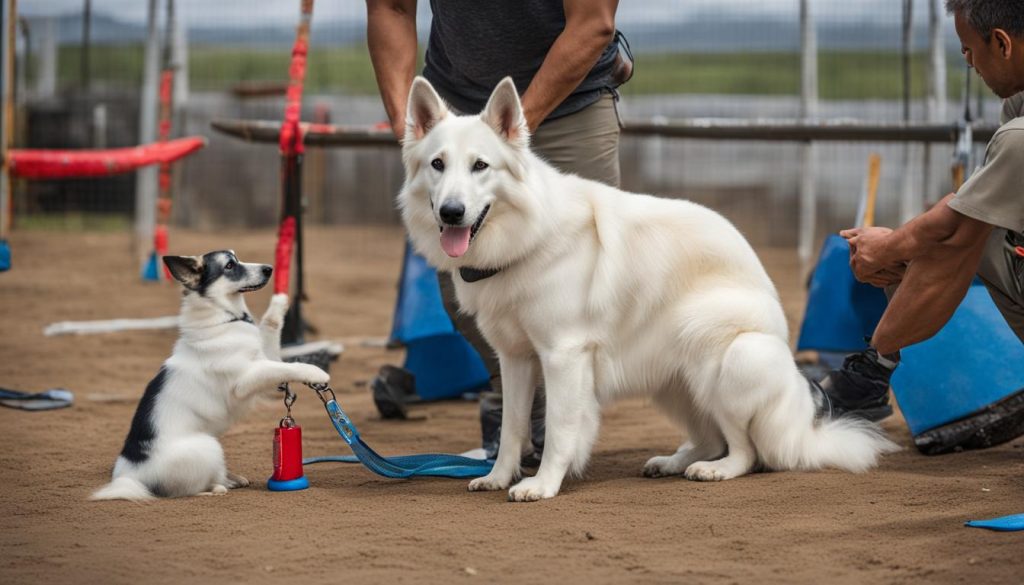Greetings! If you are a proud owner of a White Swiss Shepherd or considering getting one, you’ve come to the right place. Training your White Swiss Shepherd is an essential part of nurturing a well-behaved and happy companion. In this article, I will provide you with valuable insights and tips for effective white Swiss shepherd training.
The White Swiss Shepherd is a versatile working and companion dog known for its lively and friendly temperament. This breed is highly trainable and has a remarkable capacity for learning. Whether you are starting with a puppy or an adult dog, obedience and behavioral training should be initiated from the beginning.
Positive reinforcement techniques, such as clicker training and reward-based methods, are highly effective with White Swiss Shepherds. Consistency and firm yet loving training methods will help establish a strong bond between you and your dog. Additionally, socialization is key to ensuring your White Swiss Shepherd becomes a well-rounded and confident dog.
Are you ready to embark on this training journey with your beloved White Swiss Shepherd? Let’s dive into the world of white Swiss shepherd training, where you’ll discover valuable tips and techniques to help you create a harmonious and well-trained companion.
White Swiss Shepherd Training
- Start obedience and behavioral training from an early age.
- Use positive reinforcement techniques such as clicker training and reward-based methods.
- Be consistent, firm, and loving in your training approach.
- Socialize your White Swiss Shepherd to ensure they become well-rounded and confident.
- Consider enrolling in training classes or working with a professional trainer to enhance your training efforts.
Basic Commands Training for White Swiss Shepherds
Teaching your White Swiss Shepherd basic commands is an essential part of their obedience and safety training. By starting with simple commands and using positive reinforcement techniques, you can establish a strong foundation for further training.
Begin with commands like sit, stay, and come. To effectively communicate these commands, use consistent hand signals along with verbal cues. For example, raise your hand and say “sit” while gently pressing down on your dog’s hindquarters.
Positive reinforcement is key to motivating your White Swiss Shepherd to follow these commands. Reward your dog with treats, praise, and affection when they respond correctly. This encourages them to associate the commands with positive experiences.
Consistency is crucial in White Swiss Shepherd training. Practice the basic commands regularly and in different environments to reinforce your dog’s understanding. Gradually increase the level of distraction during training sessions to challenge their focus and obedience.

Add Variety to Training
Variety is important to keep your White Swiss Shepherd engaged and responsive during training sessions. In addition to indoor sessions, conduct training exercises in outdoor spaces like parks or quiet streets.
Introduce new distractions gradually. For example, practice commands near other dogs, people, or mild noises. This helps your dog learn to follow commands even in the presence of distractions.
Graduate to Advanced Training
Once your White Swiss Shepherd has mastered the basic commands, you can move on to more advanced training techniques. This may include commands like “down,” “heel,” “leave it,” and “wait.”
Advanced training not only provides mental stimulation for your dog but also strengthens your bond. These commands require increased focus, discipline, and trust between you and your White Swiss Shepherd.
Remember, training should always be a positive and enjoyable experience for both you and your dog. Keep White Swiss Shepherd training sessions short, frequent, and full of praise and rewards. This will ensure your White Swiss Shepherd continues to thrive and excel in their obedience training.
Behavioral Training for White Swiss Shepherds
As White Swiss Shepherds are known for their loyal and protective nature, proper behavioral training is essential to ensure they exhibit appropriate behavior. To start, it is important to set clear boundaries and rules for your dog to establish expectations. Address any unwanted behaviors, such as excessive barking or jumping, by redirecting their attention and rewarding good behavior. Consistency and positive reinforcement are key in behavioral training.
If you are encountering specific behavior issues or need extra guidance, it is recommended to consult with a professional dog trainer or behaviorist. They can offer expert advice and tailor a training plan specifically for your White Swiss Shepherd’s needs. A professional can help you identify the root causes of any behavior problems and develop effective strategies for behavior modification.
Remember, every dog is unique, so be patient and understanding throughout the training process. With consistent effort and positive reinforcement, you can help your White Swiss Shepherd develop good behavior habits and become a well-balanced and happy companion.

The Importance of Setting Boundaries and Rules
Setting clear boundaries and rules is crucial in behavioral training for White Swiss Shepherds. Dogs thrive when they understand their role within the family and know what is expected of them. Start by establishing consistent rules for behaviors such as jumping on furniture, begging at the table, or excessive barking.
Consistency is key when enforcing these rules. Make sure everyone in the household is on the same page and follows the established boundaries. Reinforce desired behaviors by providing praise or treats, and redirect your dog’s attention when they engage in unwanted behaviors.
Addressing Unwanted Behaviors
If your White Swiss Shepherd displays unwanted behaviors, it is important to address them promptly. For example, if your dog excessively barks, find ways to redirect their attention to more appropriate behaviors. You can use toys or puzzles to keep them mentally stimulated or engage in interactive play to release excess energy.
When your dog exhibits good behavior, be sure to reward them with praise, treats, or their favorite toys. Positive reinforcement encourages your dog to continue displaying desirable behaviors and reinforces the training process.
Seeking Professional Guidance
If you encounter specific behavior issues or find that your White Swiss Shepherd training efforts are not yielding the desired results, don’t hesitate to seek professional guidance. A certified dog trainer or behaviorist can provide expert advice tailored to your White Swiss Shepherd’s individual needs. They have the knowledge and experience to address complex behavior problems and help you modify your dog’s behavior effectively.
Leash Training and Socialization for White Swiss Shepherds
Leash training is an essential aspect of training your White Swiss Shepherd. It allows you to maintain control and ensure the safety of your dog during walks. To begin leash training, introduce your dog to the leash gradually and in a positive manner.
Start by attaching the leash to your dog’s collar or harness while they are in a familiar environment. Allow them to explore and get comfortable with the leash, rewarding them with treats and praise for calm behavior. Repeat this process daily, gradually increasing the duration of time your dog spends wearing the leash.
Once your White Swiss Shepherd is comfortable wearing the leash, it’s time to start walking. Choose a quiet and familiar area to begin your walks. Encourage your dog to walk by your side using verbal cues and gentle leash guidance. Reward them with treats and praise for walking calmly by your side.
Remember to be patient and consistent throughout the leash training process. With time, your White Swiss Shepherd will learn to associate the leash with positive experiences and will become more comfortable walking on a leash.
Socialization is another important aspect of White Swiss Shepherd training. Exposing your dog to different people, animals, and environments from an early age helps them become well-rounded and confident companions.
Take your White Swiss Shepherd to various places, such as parks, busy streets, and pet-friendly stores. Allow them to interact with other friendly dogs and people. Supervise these interactions and reward your dog for appropriate behavior.
Proper leash training and socialization ensure that your White Swiss Shepherd is well-behaved and confident in various situations. By investing time and effort into these training techniques, you can establish a strong bond with your dog and enjoy many enjoyable walks together.
Crate Training and House Training for White Swiss Shepherds
When it comes to house training your White Swiss Shepherd puppy, crate training is a highly effective method. The crate provides a safe and secure space for your puppy, mimicking the den-like environment that dogs naturally seek. Introducing the crate from an early age helps your puppy associate it with positive experiences, making the training process easier and more enjoyable.
Start by choosing a crate that is spacious enough for your puppy to stand, turn around, and lie down comfortably. Place a soft blanket and some toys inside to make it cozy and inviting. Encourage your puppy to enter the crate by using treats and praise. Make sure to always keep the door of the crate open initially, allowing your puppy to explore the crate at their own pace.
Once your puppy feels comfortable entering and exiting the crate, gradually close the door for short periods of time while they are inside. Start with just a few minutes and gradually increase the duration. This helps your puppy get used to being confined for longer periods without feeling anxious or stressed.
Remember to never use the crate as a form of punishment. It should always be associated with positive experiences and a safe place for your puppy. Avoid leaving your puppy alone in the crate for extended periods, as puppies have limited bladder control and need to be let out regularly.
House Training
In addition to crate training, establishing a consistent routine for house training is crucial. Take your puppy outside to a designated spot in your yard at regular intervals throughout the day, such as after meals, naps, and playtime. Be patient and wait for your puppy to eliminate. As soon as they do, reward them with praise, treats, or both to reinforce the desired behavior.
If your puppy has an accident inside the house, do not scold or punish them. Instead, clean up the mess using an enzymatic cleaner to eliminate any lingering odors that may attract your puppy to that spot again. Accidents are a normal part of the house training process, and consistency is key to helping your puppy learn where they should go.
By combining crate training and house training techniques, you can effectively teach your White Swiss Shepherd puppy to have good bladder and bowel control, creating a harmonious living environment for both you and your furry friend. Remember to be patient, consistent, and positive throughout the training process, and soon enough, your White Swiss Shepherd will become fully house trained.
Conclusion
White Swiss Shepherd training requires patience, consistency, and positive reinforcement. By starting training from a young age and using reward-based methods, you can develop a strong bond and ensure your dog’s obedience. It is important to remember that each dog is unique, so tailoring the training techniques to suit your White Swiss Shepherd’s individual needs is essential.
To enhance your training efforts, consider enrolling in white swiss shepherd training classes or working with a professional trainer. These resources can provide valuable guidance and support, helping you navigate any challenges you may encounter during the training process.
With the right White Swiss Shepherd training and guidance, your White Swiss Shepherd will become a well-behaved and happy companion. Enjoy the journey of White Swiss Shepherd training and revel in the rewarding connection you will build along the way.
FAQ
When should I start training my White Swiss Shepherd?
It is important to start obedience and behavioral training from an early age to effectively train your White Swiss Shepherd.
What training techniques work well with White Swiss Shepherds?
Positive reinforcement techniques, such as clicker training and reward-based methods, work well with this breed.
What are some basic commands to teach a White Swiss Shepherd?
Start with simple commands like sit, stay, and come, using positive reinforcement to reward your dog for correctly following the commands.
How can I address unwanted behaviors in my White Swiss Shepherd?
Set clear boundaries and rules, address unwanted behaviors by redirecting their attention, and reward good behavior using consistent and positive reinforcement methods.
How can I leash train my White Swiss Shepherd?
Introduce the leash gradually and reward your dog for walking calmly by your side. Socialization is also crucial for their development.
How can I crate train my White Swiss Shepherd?
Introduce the crate as a positive space, use treats and praise to encourage them to enter, and establish a consistent routine for bathroom breaks and rewards for going in the appropriate spot.






